- About us
- Support the Gallery
- Venue hire
- Publications
- Research library
- Organisation chart
- Employment
- Contact us
- Make a booking
- Onsite programs
- Online programs
- School visit information
- Learning resources
- Little Darlings
- Professional learning
Evelyn Chapman, artist, studied with Antonio Dattilo Rubbo in Sydney and travelled overseas to paint in Paris, where she exhibited at the Salon. A few weeks after the end of World War 1 she took up the opportunity to visit the battlefields of France with her father, who was attached to the New Zealand War Graves Commission. Thus, she became the first Australian female artist to depict the devastated battlefields, towns and churches of the western front. Chapman remained overseas with her father, an organist who played in Dieppe, Venice and elsewhere, and married a brilliant organist, George Thalben-Ball, herself. After she married, she gave up painting, but she encouraged her daughter, Pamela, to pursue art. For the rest of her life, Chapman lived in England, only returning to Australia for a visit in 1960. The Art Gallery of New South Wales has her 1911 portrait of Dattilo Rubbo and a number of her paintings of France, Belgium and England. The Australian War Memorial, too, has several of her evocative French scenes.
Gift of Pamela Thalben-Ball 2007
© Estate of Evelyn Chapman
This is a self-portrait of Evelyn Chapman. She painted it with oil on canvas in 1911 and it was donated to the Portrait Gallery by her daughter Pamela Thalben-Ball in 2007. The work measures about 1 m high by 80 cm wide in its frame. The frame consists of a slender gold gilt inner rim, surrounded by a wider outer rim in dark wood with a carved leaf pattern.
Light falls on Evelyn’s pale face and ivory coloured shawl, floating amid deep shadow. The rich blacks and browns of her hat, hair and dress merge into the dark background. Evelyn’s head is turned to the viewer, while her body, seated, is angled to the left of the image with her left elbow cocked, hand propped up on her hip. The painting style is realistic, with some visible brush strokes and other areas where tones are blended together. The portrait is in soft focus, not overly detailed, and with contrasts of light and dark creating form and depth.
The background of the painting is dark browns with patches of red-browns and greys.
Evelyn’s face is in the upper centre of the composition. She wears a large black hat, orange-brown swirls suggesting ornamentation on the crown, a wide brim, and dark hair, barely discernible from the hat, curling over her forehead.
Evelyn has straight dark eyebrows, dark eyes cast down to the right of the scene. She has a straight nose, pink-tinted cheeks, and full warm red lips in a closed rosebud. Her round chin has a crease running down the centre.
The collar of her dark dress rests just beneath her jaw, encircling her neck, dappled with grey and pink. A sumptuous cream shawl is draped over Evelyn’s shoulders, light reflecting off the thick folds of fabric that flow down over her front. The ends of the shawl spill onto her lap, with the left end tied in a knot.
Beneath the shawl, Evelyn’s dress is deep brown-black. Her left sleeve finishes just below the elbow, trimmed with a cuff patterned in turquoise-green and pink. Evelyn’s left hand is propped on her hip, fingers splayed over her shawl. Her right hand, ring finger adorned with gold rings, rests over the length of shawl over her right leg.
The portrait is cropped just below Evelyn’s lap, with her faint signature in white on the bottom right.
Audio description written by Lucinda Shawcross and voiced by Amy Middleby
Evelyn Chapman (age 23 in 1911)
Pamela Thalben-Ball (2 portraits)



On one level The Companion talks about the most famous and frontline Australians, but on another it tells us about ourselves.
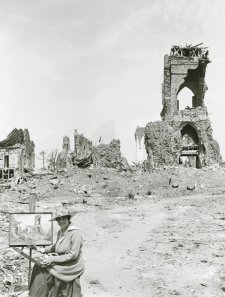
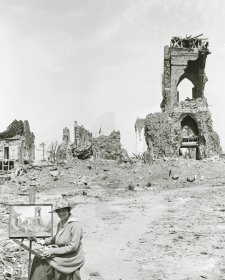
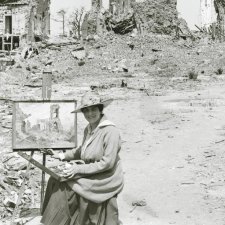
Dr Sarah Engledow traces the significant links between Antonio Dattilo-Rubbo and Evelyn Chapman through their portraits.
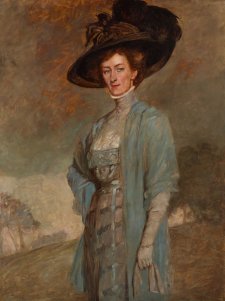
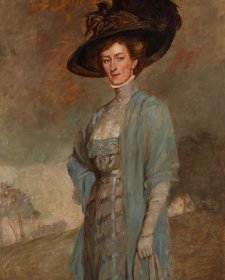
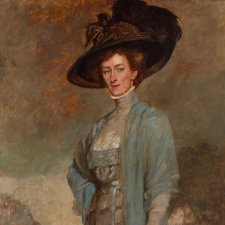
Spanning the 1880s to the 1930s, this collection display celebrates the innovations in art – and life – introduced by the generation of Australians who travelled to London and Paris for experience and inspiration in the decades either side of 1900.